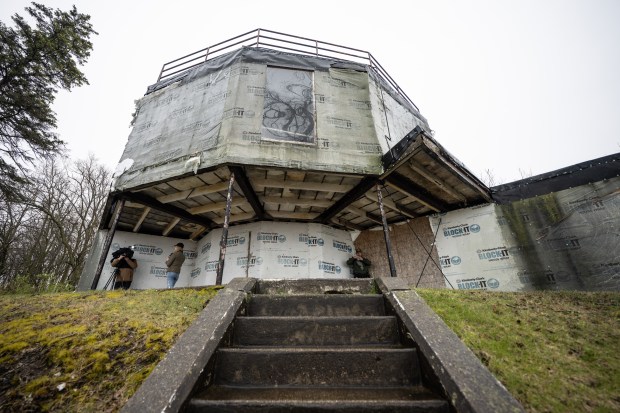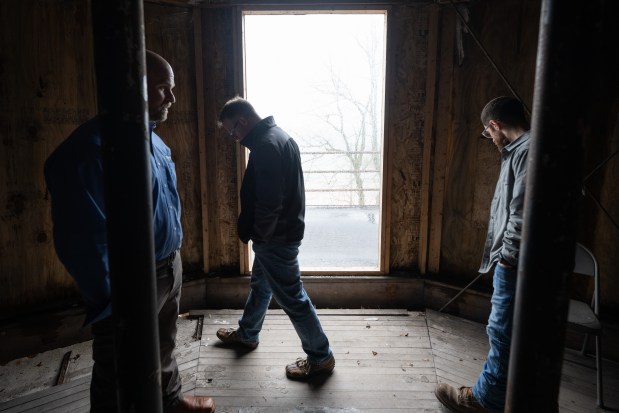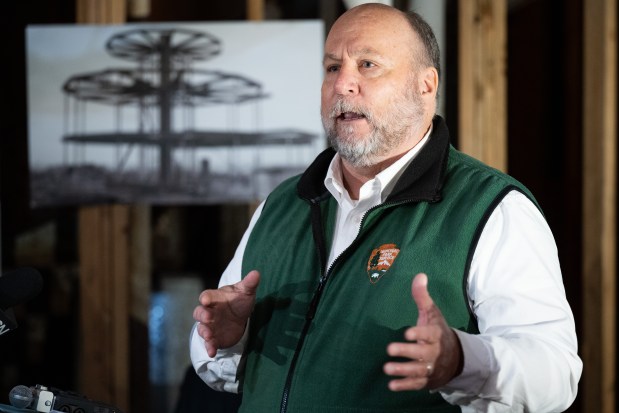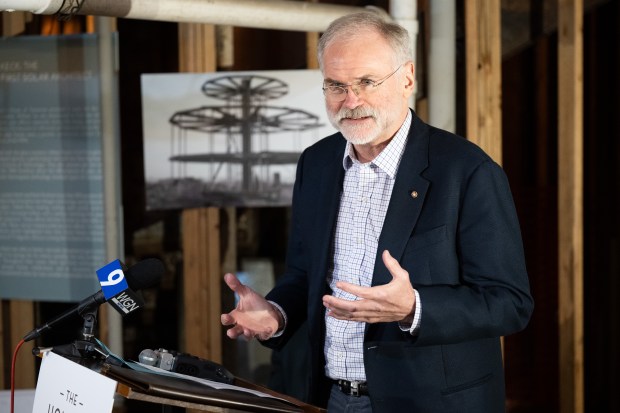Built about 90 years ago as a World’s Fair exhibit, the House of Tomorrow is about to get a new life.
“It’s official: There is a tomorrow for the House of Tomorrow,” Indiana Landmarks President Marsh Davis said Thursday at a gathering to mark the beginning of a $4 million restoration project on the historic building.
Located now along the Lake Michigan shoreline in Beverly Shores, the House of Tomorrow was built for the 1933-34 World’s Fair in Chicago to show how modern conveniences could improve life.
When the World’s Fair closed, the House of Tomorrow and four other houses built for the fair were brought to Beverly Shores.
The House of Tomorrow’s three-level, octagonal shape and glass exterior made it immediately distinctive. It also featured conveniences — a dishwasher, an electric refrigerator, a garage with an automatic door — that were innovations in the 1930s.
It became part of the Indiana Dunes National Lakeshore – now Indiana Dunes National Park — along with the rest of the Beverly Shores shoreline in the 1980s, but has been vacant since 1999.
Indiana Landmarks, which is dedicated to preserving historic buildings, leases the World’s Fair homes from the national park and has sub-leased them to people who were willing to renovate the homes – usually for well more than $1 million – and live in them.
The House of Tomorrow stood apart, Davis said, because of the “great technical and financial obstacles” to restoring it.
A turning point came in 2020 when the U.S. Congress passed the Great American Outdoors Act, which provides $1.9 billion a year for five years to address deferred maintenance projects in national parks.

Indiana Dunes National Park will use $22 million of that funding for building renovation projects this year, including $4 million for the House of Tomorrow.
“If this isn’t deferred maintenance, I don’t know what is,” Davis said, smiling, as he spoke to a small crowd on House of Tomorrow’s bottom floor, where a puddle of rainwater had gathered from Thursday’s rain.
Chicago-based Berglund Construction, with an office in Chesterton, will carry out the restoration, and Trout Glass and Mirror, of Valparaiso, will provide the glass for the building’s distinctive exterior.
Jeff Berglund, president of the building division of Berglund Construction, said he has ridden his bike past the House of Tomorrow hundreds of times and wondered what it would look like restored.
“What an honor to be a part of the team to make that a reality,” he said.

Architect Charles Hasbrouck, who designed the restoration project, noted that modern, triple-glazed windows didn’t exist in the 1930s, and the House of Tomorrow’s original air conditioning system couldn’t keep up with the heat generated by sun shining through the original glass walls. Even in winter, men working inside the building had to take off their coats on sunny days.
The original glass walls had been removed before the House of Tomorrow was moved from Chicago to Indiana in the 1930s, Hasbrouck said.
“We’re going to reconstruct it with the original intent,” he said.
The original House of Tomorrow even had a ground-floor space for parking a small airplane.
The space is still there – it’s where Thursday’s event was held – but no airplane will be parking in the house that sits on top of a hill overlooking Lake Front Drive.

The national park-funded restoration project will stabilize the building’s spoke-and-wheel structural system and replace the bottom level’s concrete floor.
Exterior restoration “will strive to reflect the house’s original construction while incorporating modern technology and conveniences to make it livable today,” an Indiana Landmarks release said.
The copper cladding that was installed on the house in 1934 was not part of architect Fred Keck’s original design and won’t be restored, Indiana Landmarks said.

The restored House of Tomorrow will have glass walls on the second and third floors, and the first floor will be finished with black-painted board.
When the building restoration is completed, Indiana Landmarks, which is leasing the building from the national park, will select a sub-lessee to complete the interior, including plumbing and electrical, in a project that – as with the other World’s Fair homes in Beverly Shores – probably would cost more than $1 million.
Todd Zeiger, director of Indiana Landmarks’ Northern Indiana regional office, added that the future sub-lessee could have a business, such as a bed-and-breakfast, there as well as a residence.
“Stay tuned,” he advised.
Tim Zorn is a freelance reporter for the Post-Tribune.





